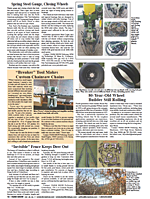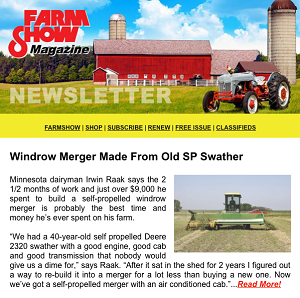You have reached your limit of 3 free stories. A story preview is shown instead.
To view more stories
To view more stories
SUBSCRIBE OR RENEW NOW
(If your subscription is current, click here to Login or Register.)2025 - Volume #49, Issue #5, Page #20
[ Sample Stories From This Issue | List of All Stories In This Issue]
Goldenseal Offers Woodland Profit Potential
For woodland entrepreneurs, goldenseal demands attention. With a range that spreads across eastern North America, the plant is known as yellow root, ground raspberry, yellow puccoon, and its Latin name, Hydrastis canadensis.Goldenseal roots contain the chemical berberine, which is responsible for their distinct..........

You must sign in, subscribe or renew to see the page.

You must sign in, subscribe or renew to see the flip-book
Goldenseal Offers Woodland Profit Potential
For woodland entrepreneurs, goldenseal demands attention. With a range that spreads across eastern North America, the plant is known as yellow root, ground raspberry, yellow puccoon, and its Latin name, Hydrastis canadensis.
Goldenseal roots contain the chemical berberine, which is responsible for their distinctive yellow color. It’s useful as a dye but also contains medicinal properties. Berberine works well for digestive problems and as a topical balm for skin and ear infections.
As word of its benefits spread, the elusive plant became prized. Intensive harvesting and habitat degradation led to its near extinction in the early 1900s. Renewed interest in herbal medicine in the 1970s helped its numbers bounce back to “vulnerable to extinction,” a classification it still carries today across most of its range.
Forest farming—using natural or modified forest habitat space to grow or produce commercially valuable non-timber forest products—offers ways for goldenseal enthusiasts to access the plant without threatening its existence. While goldenseal is classified as medicinal, other forest products might be edible or decorative.
Goldenseal thrives in rich, moist soil with slight acidity. Sugar maples are a positive sign of suitable habitat space, as their leaves provide plenty of calcium when they break down. Oak leaves, in contrast, are high in tannins and break down poorly. Even so, goldenseal is considered hardy and can thrive in a variety of locations.
Forest farming typically falls into two categories: wild-simulated and wood-cultivated. Wild-simulated goldenseal requires little more than scattering seed and monitoring its growth. The resulting plants are nearly identical to those found in nature. While this approach requires less labor, it produces relatively low yields and follows a harvest cycle of 7 to 10 years.
In contrast, wood cultivation combines traditional agriculture with forestry. Standard practices include thinning seedlings, tilling soil into raised beds, and clearing competing vegetation. This method is more labor-intensive and disturbs the natural ecosystem, but it results in higher yields in less time.
There are three main strategies for propagating goldenseal: by rhizome, seed or root. Rhizome propagation requires digging in the fall, preferably from 5 to 7-year-old plants with a flower or berry. Divide the rhizomes into 1/2-inch segments, making sure each has a bud. Plant them 2 to 3 in. deep with the bud facing upward.
Goldenseal fruit ripens in late summer, although it should be harvested early to beat out hungry turkeys. Mash the fruit, freeing the seeds, and sow immediately. This is crucial, as goldenseal requires a 30-day warm stratification period. Otherwise, the seeds might go dormant for several summers. Plant about 3/4 in. deep, covered with soil and leaf litter.
Seeds go through three stages to maturity: seedling, development and reproductive. They remain seedlings until they develop a single leaf and stem, which can take upwards of two years. They’ll stay within the development stage until they develop a forked stem and two leaves, usually around the five-year mark. Though this method is slow, it increases genetic diversity rather than merely creating clones.
The third, less popular strategy is propagating goldenseal by the roots that grow along the rhizome. Again, you’ll want to cut portions about 1/2 in. long and plant them. This strategy might take two years or longer for plants to develop.
The roots are ready for harvest between 4 and 8 years old. Harvest in late summer through fall to ensure the plant energy is traveling through to the roots. Leaves are less seasonally dependent for harvesting, although spring is preferred for the highest concentration of active compounds, like berberine. Immediately after harvesting, spray the roots with cool water through a mesh screen. This helps protect them from water pressure that could scrape up the delicate roots.
Dry the roots at around 85 to 100 F, ensuring good airflow. Too hot, and the outside might dry before the interior, increasing the risk of mold. Within a week, the roots should lose 70% of their weight. Expect to fetch around $20 to $50 per lb. of dried root, although the price increases when the roots are sold in value-added products, like tinctures. Likewise, many growers find success selling seeds or fresh roots to other interested herbalists.
To read the rest of this story, download this issue below or click here to register with your account number.



